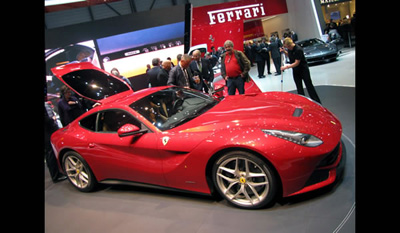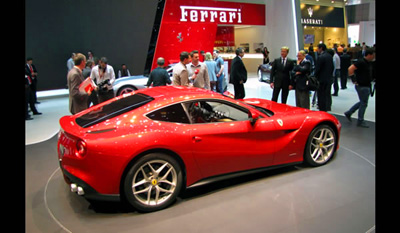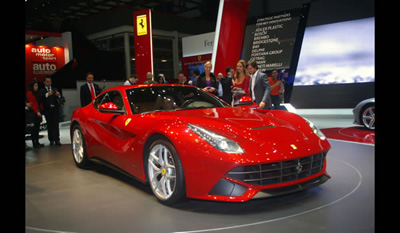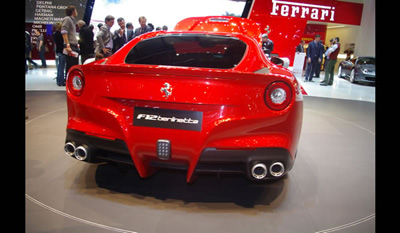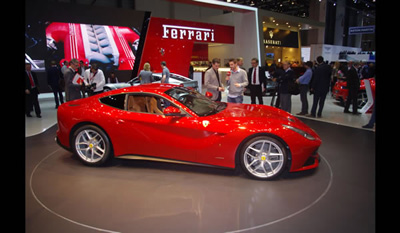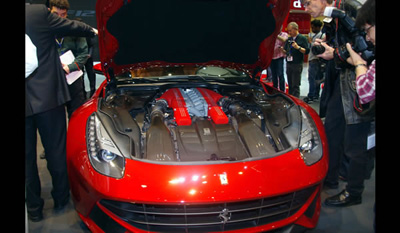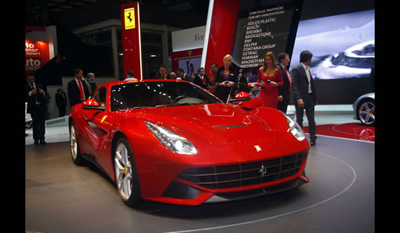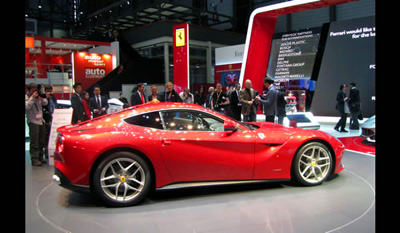Ferrari F12 Berlinetta 2012 - Pininfarina
Geneva March 2012 – Ferrari has introduced the new F12 Berlinetta that replaces the 599 Fiorano in the 12 cylinder line of models. The Ferrari F12 Berlinetta is now the most powerful and high-performance road-going Ferrari ever. A greater efficiency of the engine results in a claimed reduction by 30 per cent of the fuel consumption and emissions. The Ferrari F12, propelled by a new V12 engine, is built around highly evolved transaxle architecture and features state-of-the-art components and control systems. The Ferrari F12 Berlinetta’s aerodynamic have also been perfected to the extreme in an innovative design that redefines classic Ferrari themes. The Ferrari F12‘s wheelbase is shorter and its engine, dashboard and seats are lower in the chassis when compared to the 599 Fiorano. A new suspension and gearbox layout helped reduce the car’s rear volume. The result is a shorter, lower and narrower car than the previous V12 coupé. The Ferrari F12 Berlinetta boasts ideal weight distribution (54% over the rear axle) as well as a lower centre de gravity that is further back in the chassis. The Ferrari F12 Berlinetta’s space-frame chassis and body shell are completely new, and now incorporate no less than 12 different aluminium alloys, some of which have been used for the first time in the automotive sector. New assembly and joining technologies were also adopted in its construction. This has allowed the car’s overall weight to be kept to just 1525 kg (3362 lb.) and has maximised its performance efficiency with rigidity related to torsion boosted by 20 per cent. The new, 200-bar (2.900 psi) direct-injection 6.262 cc. 65° V12 engine delivers unprecedented performance for a naturally-aspirated 12 cylinder. It punches out a maximum of 740 hp at 8.250 rpm, with a specific power output of 118 hp/litre and maximum revolution of 8.700 rpm, record figures for this type of engine. Responsiveness and strong pick-up is guaranteed by maximum torque of 690 Nm, 80 per cent of which is readily available at 2.500 rpm.
Aerodynamics play a major role, and a host of innovative solutions have been discreetly integrated in the Ferrari F12 Berlinetta’s styling. These include the ‘Aero Bridge’ which, in a first, uses the bonnet to generate down force, and Active Brake Cooling, a system that opens guide vanes to the brake cooling ducts only at high operating temperatures. The results of these interventions is that the Ferrari F12 Berlinetta has the highest overall aerodynamic efficiency of any Ferrari ever built (a value of 1.2 double that of the 599 GTB Fiorano) with down force of 123 kg (271 lb.) at 200 kph (124 mph) and a Cd of just 0.299. The fruit of the collaboration between the Ferrari Styling Centre and Pininfarina, the Ferrari f12 Berlinetta features harmonious and balanced proportions. It is a truly original, innovative coupe with all of the signature features of an authentic Ferrari 12 cylinder. Clothed in sleek, aggressive lines, it offers superb occupant space and comfort despite its relatively compact dimensions. Research was steered towards harmonious balance of proportions, while the styling concept focuses on strong aerodynamic qualities able to sculpt and lighten the entire profile of the vehicle, eliminating everything superfluous. Exploiting zones without mechanical obstructions, an air passage has been constructed between the front bonnet and side in a perfect synthesis of form and function. Aerodynamic flow uses the bonnet to generate down force and is channelled and rerouted towards the side of the car passing under an Aero Bridge wing. This particular element channels air away from the upper part of the car to its flanks where it redirects the air from the upper part of the vehicle to the side where it interacts with the wake from the wheel wells to decrease drag. The design of the nose, based on the “keel” concept, imagines a front end constructed on two vertical volumes. All the aerodynamic features necessary for such powerful, high performance mechanicals are aligned with this theme: a generously-dimensioned air intake for the radiator, enhanced by the classical Ferrari grille; winged sections under the grille to convey the flow of air to the flat bottom; two side elements in the lower part of the body-coloured bumpers that mark the classical smile of the Ferrari mouth and integrate a new concept of active aerodynamics for cooling of the brakes: two guide vanes that open or close only if required according to temperature. In the front headlights, the DRL function consists of a light-guide that increases the car’s aggressive look at night. The Ferrari F12 Berlinetta’s technical specifications are completed by the very latest version of the carbon-ceramic braking system, a further evolution of the magnetorheological suspension and the latest development in electronic vehicle control systems. All controls are integrated in single, fast-responding CPU featuring new model-specific software.
Ferrari F12 Berlinetta 2012 - Pininfarina : Wallpapers
Related review :
|
|||||||||||||||||||||||||||||||||||||||||||||||||
|---|---|---|---|---|---|---|---|---|---|---|---|---|---|---|---|---|---|---|---|---|---|---|---|---|---|---|---|---|---|---|---|---|---|---|---|---|---|---|---|---|---|---|---|---|---|---|---|---|---|








